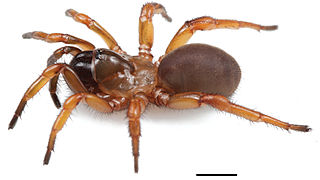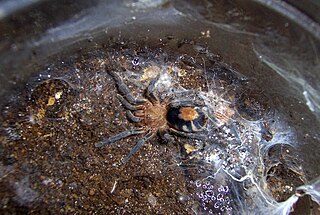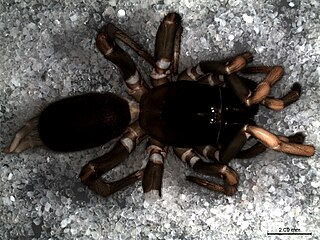
The Mygalomorphae, or mygalomorphs, are an infraorder of spiders, and comprise one of three major groups of living spiders with over 3000 species, found on all continents except Antarctica. Many members are known as trapdoor spiders due to them forming trapdoors over their burrows. Other prominent groups include Australian funnel web spiders, and tarantulas, with the latter accounting for around one third of all mygalomorphs.

The family Dipluridae, known as curtain-web spiders are a group of spiders in the infraorder Mygalomorphae, that have two pairs of booklungs, and chelicerae (fangs) that move up and down in a stabbing motion. A number of genera, including that of the Sydney funnel-web spider (Atrax), used to be classified in this family but have now been moved to Hexathelidae.

The wafer trapdoor spiders, family Cyrtaucheniidae, are a widespread family of spiders that lack the thorn-like spines on tarsi and metatarsi I and II found in true trapdoor spiders (Ctenizidae).

Hexathelidae is a family of mygalomorph spiders. It is one of a number of families and genera of spiders known as funnel-web spiders. In 2018, the family was substantially reduced in size by genera being moved to three separate families: Atracidae, Macrothelidae and Porrhothelidae. Atracidae includes the most venomous species formerly placed in Hexathelidae.

Nemesiidae, also known as funnel-web trapdoor spiders, is a family of mygalomorph spiders first described by Eugène Simon in 1889, and raised to family status in 1985. Before becoming its own family, it was considered part of "Dipluridae".

Myrmekiaphila is a genus of North American mygalomorph trapdoor spiders in the family Euctenizidae, and was first described by G. F. Atkinson in 1886. All described species are endemic to the southeastern United States.
Neischnocolus is a genus of spiders in the family Theraphosidae. It was first described in 1925 by Petrunkevitch. The genus Ami was separately described in 2008, but was later discovered to be a junior synonym of Neischnocolus. Species are native to Central America and northern South America.

Cyriocosmus is a genus of tarantulas that was first described by Eugène Louis Simon in 1903.
Cyriopagopus is a genus of southeast Asian tarantulas found from Myanmar to the Philippines. As of March 2017, the genus includes species formerly placed in Haplopelma. It was first described by Eugène Louis Simon in 1887.
Sickius is a genus of tarantulas. It has a single species, Sickius longibulbi. It is endemic to Brazil.
The Ischnocolinae are a problematic subfamily of tarantulas. In 1892, Eugène Simon based the group, which he noted was only weakly homogeneous, on the presence of divided tarsal scopulae. This feature was later considered to be plesiomorphic, and both morphological and molecular phylogenetic studies have shown that, as traditionally circumscribed, the subfamily is not monophyletic. A much more narrowly defined Ischnocolinae sensu stricto was proposed in 2014. One of the authors of that proposal subsequently said that no further taxonomic changes should be considered until there had been a more comprehensive sampling of the subfamily. As of January 2021, the status of the Ischnocolinae remains unresolved.
Euphrictus squamosus is a tarantula in the Selenogyrinae subfamily. It is native to the Congo.
The Eumenophorinae are a subfamily of tarantula spiders. They are known from genera distributed across Africa, southwestern countries in Saudi Arabia, and Madagascar and the associated islands.
Ischnocolinopsis is a genus of fossil tarantula. It has been placed in the Ischnocolinae, although this subfamily was sharply reduced in size in 2014. It is monotypic, the only species being Ischnocolinopsis acutus. It came from the Miocene period, and from the Dominican Republic. It was found in Dominican amber.
Holothele is a genus of tarantulas that was first described by Ferdinand Anton Franz Karsch in 1879. Originally placed with the curtain-web spiders, it was transferred to the tarantulas in 1980.
Stenoterommata is a genus of South American araneomorph spiders in the family Pycnothelidae. It was first described by E. L. Holmberg in 1881. Originally placed withe the Ctenizidae, it was transferred to the funnel-web trapdoor spiders in 1985, then to the Pycnothelidae in 2020. It is a senior synonym of Ctenochelus.
Trichopelma is a genus of South American and Caribbean tarantulas first described by Eugène Simon in 1888.
Rhianodes is a monotypic genus of Southeast Asian brushed trapdoor spiders containing the single species, Rhianodes atratus. It was first described by Robert Raven in 1985, and was later renamed to "Rhianodes" because the name was already attributed to a genus of weevils in the subfamily Apostasimerini. These spiders have only been found in Malaysia, Singapore, and Philippines.

Bolostromus is a genus of wafer trapdoor spiders that was first described by Anton Ausserer in 1875.
Brachionopus is a genus of South African tarantulas that was first described by Reginald Innes Pocock in 1897. It was transferred to the Theraphosidae from the Barychelidae in 1985.







